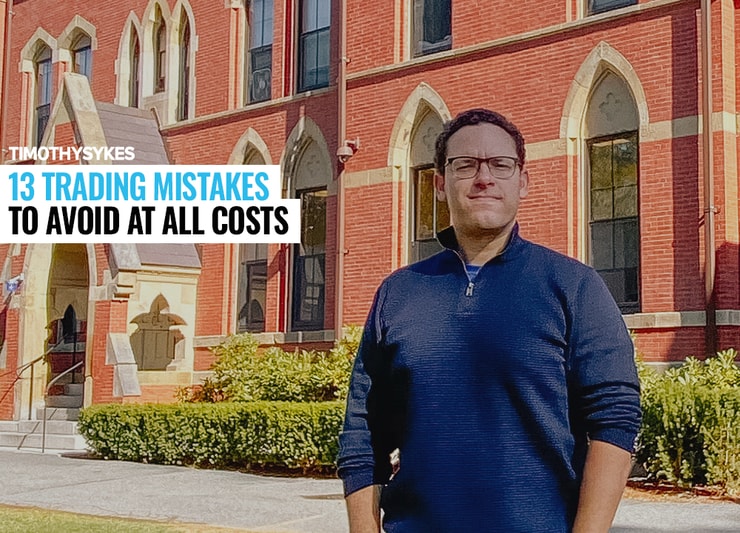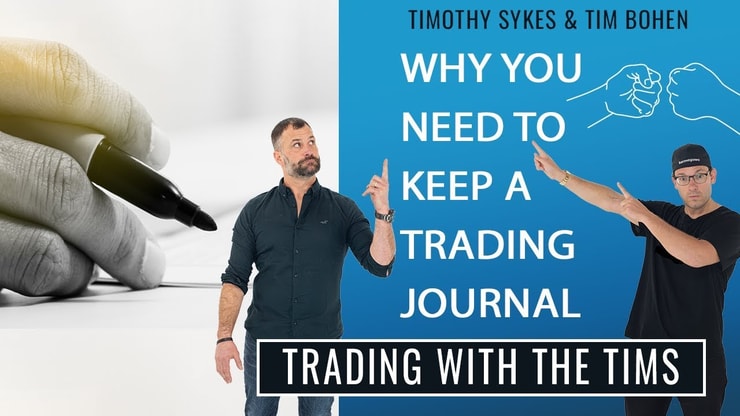We’re all human. We’re driven by our emotions, especially fear and greed.
That’s why you can memorize chart patterns until you’re blue in the face, then watch them blow up the next day. Those are tactics.
You’ve got to get the strategies right. If you want any chance of success, you need to know all the rules first.
Not only do you need to learn what to do, but you also MUST know what to steer clear of. That’s what this article is about. I’m sharing 13 mistakes that traders need to avoid like the plague.
Learn them and stay away from them!
Let’s get started …
Table of Contents
- 1 The 13 Trading Mistakes Traders Need to Avoid at All Costs
- 1.1 #1 Buying Stocks Without a Plan
- 1.2 #2 Shorting Hype Stocks too Early and Getting Demolished on Your Shorts
- 1.3 #3 Not Cutting Losses Quickly
- 1.4 #4 Buying Stocks With No Volume
- 1.5 #5 Not Keeping a Trading Journal
- 1.6 #6 Trading Too Large Position Sizes
- 1.7 #7 Trusting Stock Promoters
- 1.8 #8 Trading Difficult and Unclear Patterns
- 1.9 #9 Ignoring Indicators
- 1.10 #10 Letting Emotions Take Control of You
- 1.11 #11 Entering a Trade Based on Your Gut
- 1.12 #12 Neglecting Stop Orders
- 1.13 #13 Lack of Preparation
- 2 Bottom Line
The 13 Trading Mistakes Traders Need to Avoid at All Costs
Sometimes traders get so caught up in their trading that they forget everything else. Don’t be one of them! These are common mistakes that stock traders don’t need to make.
Trading demands focus, discipline, and knowledge. You must internalize these strategies.
#1 Buying Stocks Without a Plan
A lot of new traders enter a trade and hope the stock price increases as soon as they enter.
Anyone who has traded knows this rarely happens.
But this fact doesn’t stop beginners. If the trade starts moving against them, they’ll let their emotions take over as they find reasons to convince themselves the stock price will increase.
Next thing they know they’re down 20% from where they entered.
Reluctant to sell and take the loss, they keep holding. And the price keeps dropping and now they’re bag holding.
In other cases, a new trader may enter a stock and the price increases. They don’t sell and take profits because greed takes over. Soon enough, the trade moves against them and they’ve turned a winning trade into a losing one.
These trading mistakes are the result of not having a plan before moving into a trade.
When you enter a trade, you should be able to answer these questions:
- What am I seeing on the chart that is making me go long or short?
- What are my price targets?
- How much of my money am I willing to risk?
- At what point does this trade move against me and make it so that the trade cannot work in my favor?
If you can answer those questions, then you can set your plan with entry and exit points.
If you can’t answer those questions, don’t make the trade!
#2 Shorting Hype Stocks too Early and Getting Demolished on Your Shorts
What goes up must come down. That’s particularly true of stocks being pumped and dumped by scammy promoters.
I’ve enjoyed riding on their coattails. When I spot a stock in the very early stages of a pump, I’m glad to buy and ride along as it goes up.
And when it’s going to go down, sometimes I profit by selling short.
But you have to watch your timing. Don’t sell short too soon! Remember, hype can keep pushing a stock’s price up much longer than you can avoid bankruptcy.
You need to find where the “top” is on a stock. This starts with finding resistance levels and finding when buyers are leaving and sellers are starting to take over the stock.
For more info about short selling, check out this video I made:
#3 Not Cutting Losses Quickly
This is the biggie. This mistake probably counts for most of the money traders lose.
That’s because it’s such a common, typical human failing. We don’t want to admit we’re wrong. And in many of life’s situations, it’s even a good thing. Lots of people get by just fine refusing to admit their mistakes.
As a trader, you can’t afford that. When you make a mistake, get out … like, five minutes ago.
You will never be 100% correct on your trades. I’m not. After trading and studying the markets for twenty years I’m right about 74% of the time. That’s good, but it means I’m wrong 26% of the time.**
I haven’t blown up my account yet because I admit I’m wrong — and I get out, fast. A trade isn’t a fight for something you believe in!
You need to predetermine your risk when you enter a trade. (Remember the plan I wrote about in #1?)
- What’s the risk to reward ratio?
- How much are willing to risk?
- Once you know what you’re willing to risk, enter the trade and set your stop loss.
I’ll be the first to admit that it doesn’t feel natural to enter a trade that you think will be profitable and immediately set a stop loss, but it can protect you from incurring huge losses to your account. We’ll get more into stop losses later on in this article.
#4 Buying Stocks With No Volume
As a stock trader, you’re given information about the stock price and the volume.
But most beginner stock traders only look at the price and completely ignore volume. This is a serious mistake.
Market makers can move the stock in one direction on very little volume. You may see a stock up 10%, but if you look at the volume traded you see it’s only 5,000 shares. Avoid these traps by remembering that volume validates price.
If a stock is moving strongly in one direction or the other, it needs to be accompanied by strong volume.
Think about it this way: It takes a lot of effort to move a stock. That effort is the volume. Stocks can’t move on zero volume, and they shouldn’t be moving strongly on low volume. If stocks are moving on low volume, it’s hype. Avoid hype.
Always look at the price action and confirm it with volume. And never forget that volume validates price.
#5 Not Keeping a Trading Journal
When you think of trading, “journaling” isn’t something that usually comes to mind.
You note when you enter a trade and exit with a profit, then move on to the next trade. Right?
Nope. You have to keep a journal of ALL your trades — the good, the bad, and the ugly.
Take screenshots of the chart and the setup that you got you into each and every trade. Write down your thoughts on why you liked the chart and entered the trade.
Then write down when you exited the trade. Study your entries, exits, and timing. Learn from your success and failures. It’s one of the best ways to improve as a trader.
To learn more about how you can create a killer trading journal, check out this post.
#6 Trading Too Large Position Sizes
When you’re trading, always keep position size in mind. Don’t risk too much of your total trading account on any one trade!
When you’re just starting out you may have only a small stake to begin with. Even so, never risk your entire account on one trade unless you’re prepared to totally start over again.
You may love a chart and think the price will increase, but what you think doesn’t matter to the market. Use good judgment and proper risk management practices. Don’t pour all your money into one trade.
Test your trading strategies and rules with small position sizes. Make 50–100 trades to gauge your win rate. Once you know that, you can gradually increase your position size and refine your strategy along the way.
#7 Trusting Stock Promoters
Look, I hate to be the one to break this to you, but there’s no Santa Claus. No matter what your parents told you. And no Easter Bunny either.
I’d rather you believe in Santa Claus than trust in stock promoters.
Their job is to pump up stocks to drain all the money out of your account. Don’t join their email lists. Stay away.
After the promoter has convinced every sucker to buy the stock, they will sell their shares. Their profits come out of your trading account! Falling for their bullshit is one of the stupidest mistakes traders make.
#8 Trading Difficult and Unclear Patterns
Look at a typical stock chart. It’s not really mysterious. It’s very exact. It shows precisely the stock’s price history. Those points trace out clear, straight lines.
It’s like a picture deep inside the mind of the market, showing exactly what the market has thought of this stock.
The patterns I teach work well, but there’s a temptation to see patterns in the charts that aren’t really there. It’s not really a cup and handle, but it looks sort of like a cup and handle, so you run with it.
And then you wonder why you keep losing.
We’re all human. We’ve all thought we were in love with someone we thought was our ideal, but it turned out that person wasn’t “the one,” and that broke our heart.
Lucky for us, stock charts aren’t as hard to figure out as human beings. Stick with the patterns and indicators that are clear and unmistakable.
#9 Ignoring Indicators
The technical indicators are telling you a story about the stock, and you can’t afford not to read what it’s saying. Buy breakouts and sell breakdowns.
When the indicators tell you a trend is close to its top, take your profits. Get out of the trade.
When the indicators tell you a stock is not ready to trade yet, stay away.
Bottom line: You need to stick to your trading plan.
#10 Letting Emotions Take Control of You
The financial markets are a perpetual battle between the bulls and the bears.
When a stock’s bulls outnumber the bears, the price goes up. When the bears are stronger than the bulls, the price goes down.
And the same battle plays out in your mind, your heart, and your gut. It’s the constant push-pull of fear and greed.
That’s what leads you to make psychological trading mistakes: You let your emotions overrule your mind.
You can’t turn yourself into a cyborg trader, and that’s good. You have to harness those emotions so they serve you.
Greed is a good thing when it motivates you to work hard to learn to trade because you want to support your family, achieve financial independence, and live the laptop lifestyle.
Fear is a good thing when it prevents you from putting on stupid sure-loser trades, when it keeps you from overtrading your account, and when it tells you to close out a losing trade before you lose more money.
Stay in control. Use your head so you always know when it’s useful to feel greedy and when it’s dangerous to ignore fear.
#11 Entering a Trade Based on Your Gut
This is similar to Mistake #10. When a gut feeling is your only reason for entering a trade, that’s one of the trading mistakes too many people make while trading stocks.
It’s greed and hope controlling you instead of facts — instead of the objective reality of the chart and the market. It’s a form of fantasy. Fantasy is for books and movies, not trading penny stocks.
First, learn the main patterns and how to recognize them in a stock chart. Learn to follow trend lines. Buy breakouts and sell breakdowns. Learn from your mistakes by keeping a trading journal.
Establish the discipline of following your trading plan. When you have a good set-up, force yourself to look at it closely and analyze it before you pull the trigger.
Is it real or is it hope? Is it real or is it hype?
Allow yourself to feel the fear of losing money because you fell for a fantasy.
But once you’re sure it meets the objective criteria for a good trade, then go for it.
#12 Neglecting Stop Orders
A solid way to prevent excessive day trading losses and potentially lock in some profit when you have a winner is to make sure you set stops on every single trade.
I cover the details of how to set stop losses and trailing stops in another post. Check it out.
If you stay glued to your computer you might think you don’t need them. But sooner or later you’ll get distracted by another trade, the news, lunch, or a sudden need to rush to the bathroom. Hey, too much coffee or a stomach virus can happen to anybody.
When a stock loses support and everybody wants to get out in a rush, it can fall a lot faster than you can get your sell order in. That can wipe all your profits and much more. Set your stop-loss order as soon as your trade is filled. And like I said before, you need to predetermine this risk before you even enter the trade.
#13 Lack of Preparation
Trading stocks is not school or a lousy job. If you’re attracted to trading, you probably didn’t like teachers and bosses telling you what to do. You’re a contrary personality. I get that. It’s good, if you can harness that aspect of your personality. I’m there myself.
But if you want to succeed at trading, you must become the strictest, hardest-ass boss you’ll ever have in your life: you.
And you also need to be your boss’s hardest-working student and employee.
It takes discipline. Some people can’t handle it. They’d rather goof off and watch TV or drink too much or buy too much shit online or whatever. They’re not ready to sacrifice time and effort now to potentially grow their money.
But a major part of trading is preparing to trade.
Create your watchlist. I’ll even send you my watchlist every Sunday night. So you have no excuses.
Go through your scans of the largest percentage gainers. Look at what patterns have and have not been working. Build a watchlist and diligently tend to it.
You know the drill, so do it. The more trading experience you gain, the more you’ll develop this automatic habit.
Trading Challenge
When I started out as a trader, I wish I’d had someone to help me figure out what trading mistakes to avoid. Instead, I had to figure it out the hard way because there weren’t any great resources out there.
I want to make trading more accessible to others by becoming that resource for my students.
I created my Trading Challenge so that my students don’t have to go through the learning curve of the stock market the hard way.
There’s so much confusion and so many mixed messages out there that it’s hard to know what’s what. It’s why many traders get frustrated and quit before they realize their full potential. But it doesn’t have to be that way!
I want to help others learn my techniques to potentially take advantage of them, too. As a teacher/mentor, I’m actively trading with a small account alongside you so that my teachings can be super specific and tailored to the market as it is right now.
If you’re just getting started or your trading isn’t where you want it to be, my Challenge could be right for you.
Bottom Line
Trading isn’t easy, and that’s good. If it were easy, it wouldn’t be fun — or potentially really friggin’ profitable.
I’ll say it again: we’re human. And we all come with brains and nervous systems that didn’t evolve to make us perfect traders.
We all have cognitive biases — we don’t see reality straight on. And those that think they do are kidding themselves in a huge way. We’re designed to gather and hunt food, not stare at numbers and graphs all day, thinking about trading accounts and the future.
Do your research, practice, and learn. Keep your emotions under control. Some greed is good or you wouldn’t want to trade stocks. Some fear is good or you’d lose all your money. Just don’t let your emotions overturn your trading knowledge.
Yeah, that’s easy to say, but it’s hard to do when the markets are open and busy. But once you practice and get the hang of it, you’ll be really glad you did.
Now that you’ve learned these mistakes, think about them and figure out how many of them you’re making. Be honest with yourself; your financial future is at stake here. (And don’t just keep them in your head; write them down in your trading journal!)
Not losing money by making these mistakes is way over half the battle. Making a potential profit by finding a few winners can be easy compared to eliminating these problems. Start your discipline regime now.
Are you making some of these trading mistakes? What’s your biggest culprit? Share your comments. Your story could help other traders — and that, in my opinion, is what it’s all about. So sound off below!










Leave a reply